Ifb Appliances Electric Dishwasher NEPTUNE FX User Manual
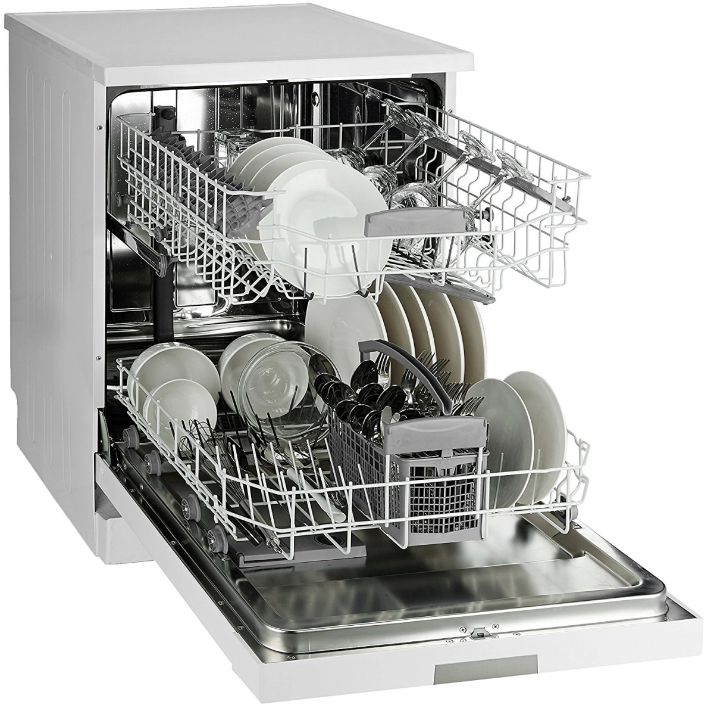
Content
Introduction
The IFB Appliances Electric Dishwasher NEPTUNE FX is a state-of-the-art kitchen appliance designed to simplify dishwashing tasks. With a capacity to accommodate up to 12 place settings, it features multiple wash programs tailored for various needs, including heavy, eco, and quick washes. The energy-efficient design ensures low water and electricity consumption, making it environmentally friendly. Priced at approximately $850, the NEPTUNE FX combines performance and convenience, making it an ideal choice for modern households.
Overview Diagram
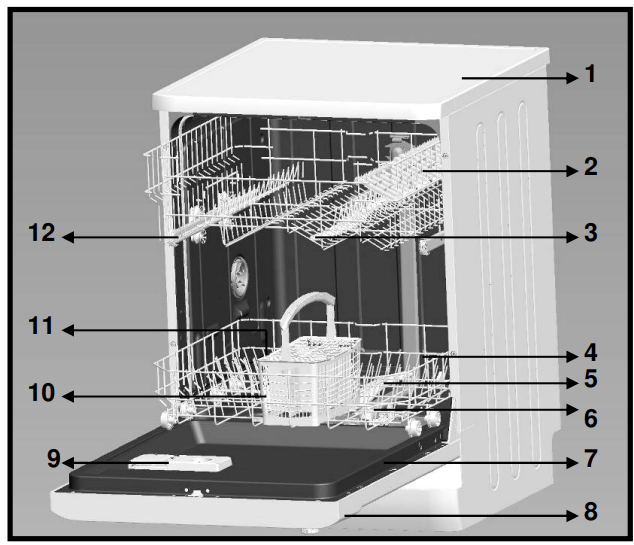
| No. | Component |
|---|---|
| 1 | Worktop |
| 2 | Upper basket with racks |
| 3 | Upper spray arm |
| 4 | Lower basket |
| 5 | Lower spray arm |
| 6 | Filters |
| 7 | Rating plate |
| 8 | Control Panel |
| 9 | Detergent and rinse-aid dispenser |
| 10 | Cutlery basket |
| 11 | Salt dispenser |
| 12 | Upper basket track latch |
Specifications
Capacity | 12 place settings |
Height | 850 mm |
Height (without worktop) | 820 mm |
Width | 598 mm |
Depth | 598 mm |
Net Weight | 46 kg |
Electricity input | 220-240 V, 50 Hz |
Total Power | 1900 W |
Heating Power | 1800 W |
Pump Power | 100 W |
Drain Pump Power | 30 W |
Water supply pressure | 0.03 MPa (0,3 bar)-1 MPa (10 bar) |
Current | 10 A |
Description
The IFB Appliances Electric Dishwasher NEPTUNE FX boasts a sleek and modern design that fits seamlessly into any kitchen decor. Its stainless steel interior ensures durability and resistance to corrosion. The dishwasher features a user-friendly interface with a digital display that allows you to select from various wash cycles and monitor the progress of your wash.
The NEPTUNE FX also includes advanced features such as steam wash for tougher stains and an anti-bacterial filter to ensure hygienic cleaning. The smart sensors automatically detect the soil level of the dishes and adjust water and energy usage accordingly, making it highly efficient.
INSTALLING THE MACHINE
Positioning the machine
- When determining the place to put your machine on, take care to choose a place where you can easily load and unload your dishes.
- Do not put your machine in any location where there is the probability for the room temperature to fall below 0°C.
- Before positioning, take the machine out of its packaging by following the warnings located on the package.
- Position the machine close to a water tap or drain. You need to site your machine, taking into consideration that its connections will not be altered once they are made.
- Do not grip the machine by its door or panel in order to move it.
- Take care to leave a certain clearance from all sides of the machine so that you can comfortably move it back and forth during cleaning.
- Make sure that the water inlet and outlet hoses do not get squeezed while positioning the machine. Also, make sure that the machine does not stand on the electrical cable.
- Adjust the machine’s adjustable feet so that it can stand level and balanced. Proper positioning of the machine ensures problem-free opening and closing of its door.
- If the door of you machine does not close properly, check if the machine is stable on the floor it stands; if not, adjust the adjustable feet and ensure its stable position.
Water connection
Be sure that the indoor plumbing is suitable for installing a dishwasher. Also, we recommend that you fit a filter at the entrance of your place or apartment so as to avoid any damage to your machine because of any contamination (sand, clay, rust etc.) that might be occasionally carried in through the mains water supply or the indoor plumbing, and to forestall such complaints as yellowing and formation of deposits after washing.
Water inlet hose
Do not use the water inlet hose of your old machine,if any. Use the new water inlet hose supplied with your machine instead. If you are going to connect a new or long - unused water inlet hose to your machine ,run water through it for a while before making the connection. Connect the water inlet hose directly to the water inlet tap. The pressure supplied by the tap should be at a minimum of 0.03 Mpa and and at a maximum of 1 Mpa.If the water pressure is above 1 Mpa,a pressure-relief valve should be fitted inbetween.
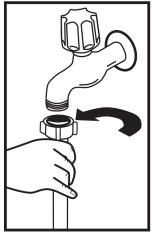
After the connections are made, the tap should be turned on fully and checked for water tightness.For the safety of your machine, make sure to always turn off the water inlet tap after each wash programme is finished.
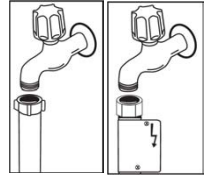
NOTE: Aquastop water spout is used in some models. In case of using Aquastop, a dangerous tension exists. Do not cut Aquastop water spout. Do not let it get folded or twisted.
Water outlet hose
The water drain hose can be connected either directly to the water drain hole or to the sink outlet spigot. Using a special bent pipe (if available), the water can be drained directly into the sink via hooking the bent pipe over the edge of the sink. This connection should be at a minimum of 50 cm and at a maximum of 110 cm from the floor plane.
Warning: When a drain hose longer than 4 m is used, the dishes might remain dirty. In that case, our company will not accept responsibility.

Electrical connection
- The earthed plug of your machine should be connected to an earthed outlet supplied by suitable voltage and current. If there is no earthing installation, have a competent electrician carry out an earthing installation. In case of usage without earthing installed, our company will not be responsible for any loss of usage that might occur.
- The indoor fuse current value should be 10-16 A.
- Your machine is set according to 220-240 V. If the mains voltage in your location is 110 V, connect a transformer of 110/220 V and 3000 W inbetween. The machine should not be plugged in during positioning.
- Always use the coated plug supplied with your machine.
- Running in low voltage will cause a decline in washing quality.
- The machine’s electrical cable should be replaced by an authorised service or an authorised electrician only. Failure to do so may lead to accidents.
- For safety purposes, always make sure to disconnect the plug when a wash programme is finished.
- In order not to cause an electric shock, do not unplug when your hands are wet.
- When disconnecting your machine from the mains supply, always pull from the plug. Never pull the cord itself.
Fitting the machine under counter
If you wish to fit your machine under-counter, check whether you have sufficient space under your countertop and whether the wiring-plumbing is suitable to do so.1 If you decide that the space under the countertop is suitable for fitting your machine, remove the worktop as shown in the illustration. 2

Warning: The stand part which we will settle our machine under it by removing its worktop has to be stable in such a way not to allow balance disorder.
- To remove the worktop, remove the screws that hold the worktop which are located at the rear of the machine; then push the front panel 1 cm from the front side towards the rear and lift it.
Adjust the machine feet according to the slope of the floor.3 Fit your machine by pushing it undercounter without letting the hoses get crushed or bent.4
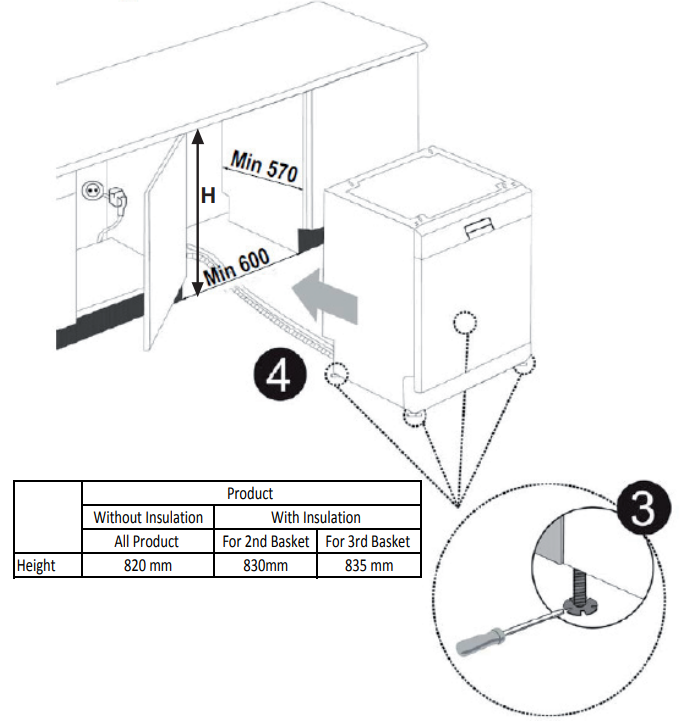
Warning: After removal of worktop, the machine should be placed in such a closed place of which dimensions are shown at fig.
Prior to using the machine for the first time
- Check whether the electricity and supply water specifications match the values indicated by the installation instructions for the machine.
- Remove all packaging materials inside the machine.
- Set the water softener.
- Add 1 kg salt into the salt compartment and fill with water up to a level at which it will almost overflow.
- Fill the rinse aid compartment.
PREPARING THE MACHINE FOR USE
The importance of water decalcification
For a good washing function, the dishwasher needs soft, i.e. less calcareous water. Otherwise, white lime residues will remain on the dishes and the interior equipment. This will negatively affect your machine’s washing, drying and shining performance. When water flows through the softener system, the ions forming the hardness are removed from the water and the water reaches the softness required to obtain the best washing result. Depending on the level of hardness of the inflowing water, these ions that harden the water accumulate rapidly inside the softener system. Therefore, the softener system has to be refreshed so that it operates with the same performance also during the next wash. For this purpose, dishwasher salt is used.
Filling with salt
Use softener salt specifically produced for use in dishwashers. To put softener salt, first remove the lower basket and then open the salt compartment cap by turning it counterclockwise. 1 2 first fill the compartment with 1kg salt and water 3 at overflowing level If available,using the funnel 4 provided will make filling easier; refit the cap and close it.
After every 20th-30th wash, add salt into your machine until it fills up (approx. 1 kg) Fill the salt compartment with water at first use only. We recommend that you use small-grained or powder softener salt.
Do not put table salt into your machine. Otherwise, the function of the softener compartment may decrease over time. When you start your dishwasher, the salt compartment gets filled with water. Therefore, put the softener salt prior to starting your machine.
This way, overflowing salt gets immediately cleaned up through the wash operation. If you are not going to wash any dishes immediately after putting salt, then run a short washing program with an empty machine in order to avoid any damage ( to prevent corrosion ) to your machine due to the salt overflow while filling in the salt container.
In order to understand whether or not the amount of softener salt in your machine is sufficient, check the transparent section on the salt compartment cap. There is sufficient salt if the transparent section is green. Salt has to be added if the transparent section is not green.
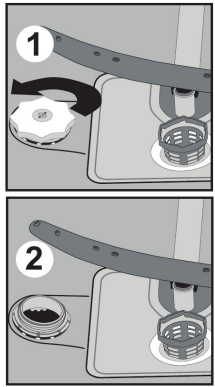

Testing strip
The washing effectiveness of your machine depends on the softness of the tap water. For this reason, your machine is equipped with a system that reduces the hardness in mains water supply. The washing effectiveness will increase when the system is correctly set. To find out the water hardness level of water in your area, contact your local water board or determine water hardness level by using the test strip(if available).

Adjusting salt consumption
Table of Water Hardness Level Settings
Water hardness degree | German hardness dH | French hardness dH | British hardness dH | Water hardness indicator |
1 | 0-5 | 0-9 | 0-6 | Wash light is on. |
2 | 6-11 | 10-20 | 7-14 | End light is on. |
3 | 12-17 | 21-30 | 15-21 | Start/Pause key is on. |
4 | 18-22 | 31-40 | 22-28 | Wash light is on. End light is on. |
5 | 23-31 | 41-55 | 29-39 | Wash light is on. Start/Pause key is on. |
6 | 32-50 | 56-90 | 40-63 | End light is on. Start/Pause key is on. |
If the hardness of the water you use is above 90 dF (French hardness) or if you are using well water; you are recommended to use filter and water refinement devices.
NOTE: Hardness level is adjusted to level 3 as a factory setting.
Adjusting salt consumption
In accordance with the degree defined on the test track, perform the water hardness setting of your machine as indicated below.

- Set the On/Off button (4) to off position (1).
- Press and hold Start/Pause (3) key.
- Set the On/Off button (4) to number 2 position by rotating it clockwise (righ-tward) 1 step.
- Hold your finger on the Start/Pause (3) key till all the lights flash and then the "water hardness degree indicator" predefined on your machine is displayed, (see setting table for water hardness degree).
- You can configure the settings according to the setting table for water hardness degree by pressing Start/Pause key (3).
- After selecting the water hardness degree, cut off the power of the machine by switching the On/Off button (4) to off position (1). The last selected water hard-ness setting will be stored in the memory.
Warning: In case of moving, to configure the water hardness setting according to the water hardness of the area you have moved is important for the effectiveness of washing.
Detergent usage
- Use a detergent specifically designed for use in domestic dishwashers.
- You can find powder,gel,and tablet detergents in the market that have been designed for household dishwashers.
- Detergent should be put into the compartment prior to starting the machine. Keep your detergents in cool, dry places out of reach of your children.
- Do not fill detergent into the detergent compartment more than required; otherwise it may cause scratches on your glasses as well as lead to a poorly dissolved detergent.
- Should you need more information concerning the detergent you will use, contact detergent manufacturers directly.
Filling the detergent compartment
- Push the latch to open the detergent container as shown in the image. 1 Detergent pod has level lines inside. It is possible to measure the right detergent amount using these lines. Detergent pod can take totally 40 cm3 detergent.
- Open the dishwasher detergent and pour into the larger compartment b 25 cm3 if your dishes are heavily soiled or 15 cm3 if they are less soiled.2 If your dishes have been kept dirty for a very long time, if there are dried food wastes on them, and if you have overly loaded the dishwasher, pour a 5cm3 detergent into the pre-wash compartment and start your machine.
You may have to add more detergent into your machine, depending on the degree of soil and on the water hardness level in your area.

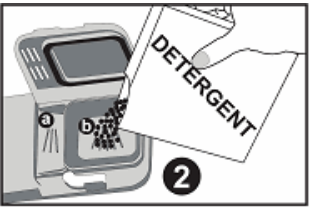
Combined detergents
Detergent manufacturers also manufacture combined detergents that are called 2 in 1 – 3 in 1- 5 in 1... The 2 in1 detergents contain detergent+ salt or rinse aid . While using the 2 in 1 detergents, it should be observed which functions the tablet consists of. The other tablet detergents also have detergent+rinse aid +salt+various extra functions. Generally, combined detergents produce sufficient results under certain usage conditions only. Such detergents contain rinse aid and/or salt in preset amounts.
Points to consider when using this type of product
- Always make sure to check the specifications of the product you will use or whether or not it is a combined product.
- Check if the detergent used is appropriate for the hardness of mains water that machine is appertaining to.
- Observe the instructions on packagings when using such products.
- If such detergents are in the form of tablets, never put them into the interior section or the cutlery basket of the dishwasher. Always put the tablets into the detergent compartment in the detergent dispenser.
- They produce good results for certain types of usage only. If you are using this type of detergents, you need to contact the manufacturers and find out about the suitable conditions of use.
- When the conditions of use of such products and the machine settings are appropriate, they ensure savings in salt and/or rinse aid consumption.
- Contact the detergent manufacturers if you are not obtaining good wash results (if your dishes stay calcareous and wet) after having used 2 in 1 or 3 in 1 detergent. The scope of warranty for your machine does not cover any complaints caused by the use of these types of detergents.
Recommended usage: If you want to obtain better results while using combined detergents, add salt and rinse aid into your machine and adjust the water hardness setting and the rinse aid setting to the lowest position.
Solubility of the tablet detergents produced by different companies can vary depending on the temperature and time. Therefore, it is not recommended to use such detergents in short programs. It is more suitable to use powder detergents in such programs.
Warning: Should any problem, which you have not encountered before, arise with the use of this type of detergents, contact the detergent manufacturers directly.
When you give up using combined detergents
- Fill the salt and rinse aid compartments.
- Adjust the water hardness setting to the highest position and run an empty-wash.
- Adjust the water hardness level.
- Make the suitable rinse aid setting.
Filling with rinse aid and making the setting.
Rinse aid is used to prevent the stay of white water drops, lime stains, white film strip-shaped stains that may form on the dishes, as well as to increase the drying performance. Contrary to the popular beliefs, it is used not only for obtaining shinier dishes but also for obtaining sufficiently dried dishes. For this reason, care should be taken that there is adequate amount of rinse aid in the rinse aid compartment and only polishing material produced for use at dishwashers should be used.
To put rinse aid, remove the rinse aid compartment cap by turning it. Fill the rinse aid compartment with rinse aid until the rinse aid level indicator becomes dark;2 refit the cap and close it by turning it in a way that the nails will correspond to one another. By checking the rinse aid level indicator on the detergent dispenser, you can understand whether or not your machine needs rinse aid. A dark indicator b means that there is rinse aid in the compartment, while a light indicator a shows that you need to fill the compartment with rinse aid.
The rinse aid level adjuster can be set to a position between 1 and 6. Factory setting for rinse aid is the position 3. You need to increase the degree of the adjuster if water stains form on your dishes after a wash, whereas you need to decrease the degree if a blue stain is left when wiped by hand.3
Warning: Use only those rinse aid materials which are allowed for use in the machine. As rinse aid residues left as a result of overflowing will create extremely high amounts of foam and thus reduce the washing performance, remove the excess amount of rinse aid by wiping it with a rag.

Programme Selection and Operating the Machine

- Door Handle
Use the door handle to open/close the door of your machine. - Delay and Half Load Button
Thanks to the delay function in your machine, by using the Delay key you can delay the start-up time of the program-me for 3-6-9 hours.
Upon pressing the delay key 3h washing light will be lit. If you keep on pressing the Delay key , 6h-9h lights will be lit respec-tively on your each press. You will cancel the delay if you press the delay key again after the 9h light is lit.
You will activate the delaying function once you select the delay time and then press the Start/Pause key. The count-down will be triggered after that mo-ment. If you would like make any change in the delay time after the delaying func-tion is enabled, you can set the new time with the button number 2 by pressing the Start/Pause key. Press the Start/Pause key again to activate it.
Once the delay time is terminated, the delay light will go off and the programme you have selected will start operating. If you press Delay key while the 9h delay light is on, the delay light will go off. If you press Start/Pause key while the delay lights are turned off, the programme you have selected will start without delay. If the user switches the programme selection button to off position after enabling the delay time and the prog-ramme is started, the activated delay function will have been cancelled. The half load function will be activated and the half load LED will be lit if the key number 2 is pressed and hold for 3 seconds.
Press the key number 2 for 3 seconds to cancel the half load function. The half load LED will go off.
Thanks to the half load function in your machine, you can shorten the durations of the programmes that you have selected and reduce the energy and water consumption. (see prog-ramme listing p 24)
NOTE: If you have used any extra function (such as delay or half load) in the washing programme that you last used and then cut off the energy of the machine and re-energised it, that function you have selected will not be active in the next washing programme. If you would like to use this feature in the programme you have newly selec-ted, you may select the desired functi-ons once again. - Start/Pause Key
When you press the Start/Pause key, the programme you have selected with the programme selection button will start operating and the washing light will be lit. After the programme is started, the Start/Pause light will go off.
You can press Start/Pause key if you wo-uld like to stop the programme. In such case, the light on the Start/Pause key will blink. You can allow the programme to resume by pressing the Start/Pause key again. - On/Off Programme Selection Button
When in off position, it cuts off the energy of the machine. In other positions, the machine is energised and program-me selection can be performed. - Programme Monitoring Lights
You can monitor the programme flow with the programme lights on the control panel.- Wash
- Dry
- End
- Salt Missing Warning Indicator
Check the salt missing warning indicator light on the display to have an idea whet-her the softening salt in your machine is enough. When salt missing warning indi-cator is lit, fill the salt compartment. - Rinse Aid Missing Warning Indica-tor
Check the rinse aid missing warning in-dicator light on the display to have an idea whether the amount of the rinse aid in your machine is enough. When rinse aid missing warning indicator is lit, fill the rinse aid compartment.
Operating the Machine

Programme Monitoring
You can monitor the programme flow with the programme lights on the control panel.

Changing the Programme
If you would like change a programme while a washing programme is running on:
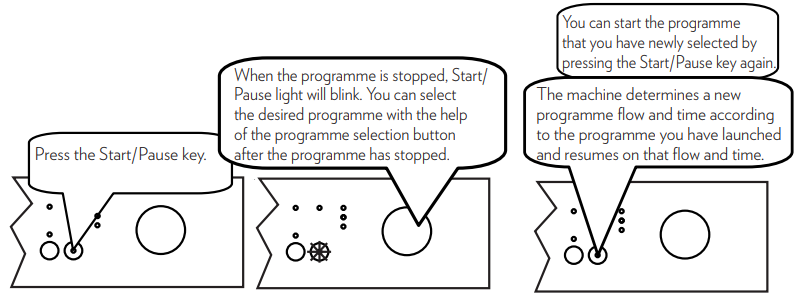
Cancelling the Programme
If you would like cancel a programme while a washing programme is running on:
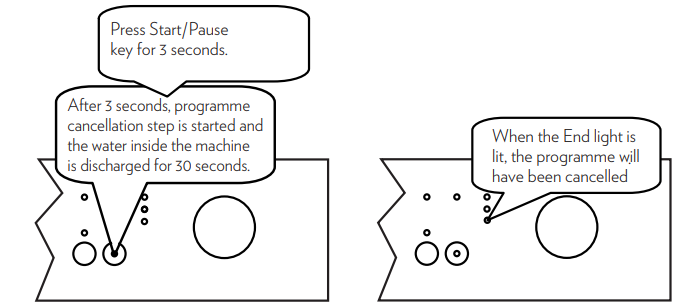
Switching the Machine Off
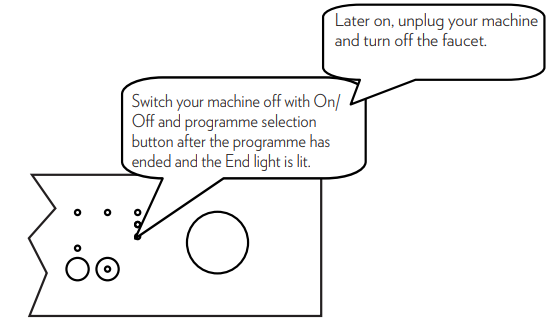
- NOTE: In order for the drying process to be performed more quickly, you may slightly open the machine door after few minutes when the programme has ended and the End light has been lit.
- NOTE: The washing programme resumes on where it has left if the machine door is opened and then closed or if the machine power is cut off and then supplied during the washing process.
- NOTE: If the power is interrupted or if the machine door is opened and then closed during the drying process, the programme is terminated. And your machine becomes ready for the new programme selection.
Setup Guide
To operate the IFB Appliances Electric Dishwasher NEPTUNE FX,
- Start by unpacking and placing it in your desired location. Ensure proper leveling to prevent any vibration during operation.
- Connect the dishwasher to a water supply line and electrical outlet as per the manual instructions.
- Load your dishes according to the recommended layout, ensuring that all items are securely placed and facing the center of the dishwasher.
- Select your desired wash cycle using the control panel, and press start. The dishwasher will automatically adjust settings based on its sensors for optimal cleaning.
MAINTENANCE AND CLEANING
Cleaning the machine in regular intervals prolongs the machine’s service life.
Oil and lime may accumulate in the machine’s washing section. In case of such accumulation; -Fill the detergent compartment without loading any dishes into the machine, select a programme that runs at high temperature, and start the machine. In case of insufficiency, use special cleansing material available in the market. (Cleansing material produced special to machines by detergent producers.)
Cleaning the seals in the machine door
To clean any accumulated residues in the door seals, wipe the seals regularly by using a dampened cloth.
Cleaning machine
- Clean the filters and spray arms at least once a month.
- Unplug your machine and turn off its tap before starting the cleaning.
- Do not use hard materials when cleaning your machine. Wipe with a fine cleaning material and a dampened cloth.
Filters
Check if any food wastes have remained on the coarse and fine filters.
If any food wastes are left, remove the filters and clean them thoroughly under the water tap.
a. Micro Filter
b. Coarse Filter
c. Metal/Plastic Filter

- To remove and clean the filter combination, turn it counter clockwise and take it out by lifting upwards.1
- Pull and remove the metal/plastic filter. 3
- Then pull the coarse filter out of the micro filter.2
- Rinse it with lots of water under the tap. Refit the metal/plastic filter.
Insert the coarse filter into the micro filter in a way that the marks will correspond to one another. Attach micro filter into the metal/plastic filter and turn to the direction of arrow and it is locked when the arrow on micro filter can be seen from across. 4

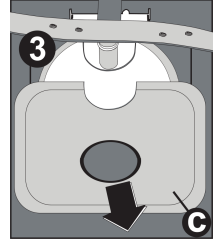
- Never use your dishwasher without any filter.
- Incorrect fitting of the filter will reduce the washing effectiveness.
- Clean filters are very important in terms of the proper running of the
Spray arms
Check whether or not the holes for the upper and lower spray arms are clogged. If there is any clogging, remove the spray arms and clean them under water.
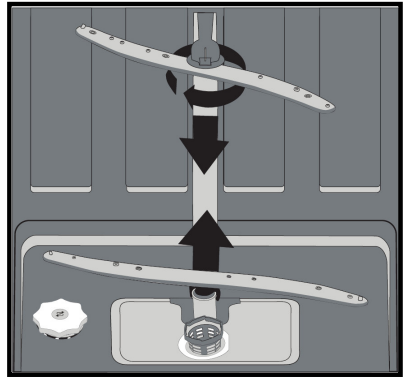
You can remove the lower spray arm by pulling it upwards, while the upper spray arm nut can be removed by turning the nut to the left. Be sure that the nut is perfectly tightened when refitting the upper spray arm.
Hose filter
Water is prevented by the inlet hose filter so as to avoid any damage to your machine because of any contamination (sand, clay, rust etc.) that might be occasionally carried in through the mains water supply or the indoor plumbing, and to forestall such complaints as yellowing and formation of deposits after washing.
- Check the filter and the hose from time to time and clean them if necessary.
- To clean the filter, first turn off your tap and then remove the hose. After removing the filter from the hose, clean it under the tap.
- Insert the cleaned filter back into its place inside the hose. Refit the hose.
SAFETY INFORMATION AND RECOMMENDATIONS
Recycling
- Certain components and the packaging of your machine have been produced from recyclable materials.
- Plastic parts are marked with international abbreviations:(>PE< , >PS< , >POM<, >PP<, )
- Cardboard parts have been produced from recycled paper and they should be disposed of into waste paper collection containers for recycling.
- Such materials are not suitable for being disposed of into garbage bins. They should be delivered to recycling centres instead.
- Contact relevant centres in order to obtain information on methods and points of disposal.
Safety Information
When you take delivery of your machine
- Check for any damage to your machine or to its packaging. Never start a machine damaged in any way, make sure to contact an authorised service.
- Unwrap the packaging materials as indicated and dispose of them in accordance with the rules.
The points to pay attention during machine installation
- Choose a suitable, safe and level place to install your machine.
- Carry out the installation and connection of your machine by following the instructions.
- This machine should be installed and repaired by an authorised service only.
- Only original spare parts should be used with the machine.
- Before installing, be sure that the machine is unplugged.
- Check whether the indoor electrical fuse system is connected according to the regulations.
- All electrical connections must match the values indicated on the rating plate.
- Pay special attention and be sure that the machine does not stand on the electricity supply cable.
- Never use an extension cord or a multiple socket for making a connection. The plug should be comfortably accessible after the machine has been installed.
- After installing the machine to a suitable place, run it unloaded for the first time.
In daily use
- This machine is for household use; do not use it for any other purpose. Commercial usage of the dishwasher will void the guarantee.
- Do not get up, sit or place a load on the open door of the dishwasher, it may fall over.
- Never put into the detergent and rinse aid dispensers of your machine anything other than those detergents and rinse aids which are produced specifically for dishwashers. Our company will not be responsible for any damage that might occur in your machine otherwise.
- The water in the machine's washing section is no drinking water do not drink it.
- Due to danger of explosion, do not put into the machine’s washing section any chemical dissolving agents such as solvents.
- Check whether plastic items are heat-resistant before washing them in the machine.
- This appliance can be used by children aged from 8 years and above and persons with reduced physical, sensory or mental capabilities or lack of experience and knowledge if they have been given supervision or instruction concerning use of the appliance in a safe way and understand the hazards involved. Children shall not play with the appliance.Cleaning and user maintenance shall not be made by children without supervision.
- Do not put into your machine those items which are not suitable for dishwashing. Also, do not fill any basket above its capacity.Our company will not be responsible for any scratch or rust to form on the inner frame of your machine due to basket movements otherwise.
- Especially because hot water may flow out, the machine door should not be opened under any circumstances while the machine is in operation. In any case, a safety devices ensures that the machine stops if the door is opened.
- Do not leave your dishwasher’s door open. Failure to do so may lead to accidents.
- Place knives and other sharp-ended objects in the cutlery basket in blade-down position.
- If the supply cord is damaged, it must be replaced by the manufacturer, its service agent or similarly qualified persons in order to avoid a hazard.
- This appliance is not intended for use by persons (including -children) with reduced physical,sensory or mental capabilities, or lack of experience and knowledge, unless they have been given supervision or instruction concerning use of the appliance by a person responsible for their safety.
- If EnergySave option is selected as "Yes", The door will be opened at the end of the program. Do not force to close the door to avoid harm auto door mechanism during 1 minutes. The door must be open during 30 minutes to get effective drying.( in models with auto door opening system ) Warning: Do not stand in front of the door after the signal sounds belonging auto-open.
For your children’s safety
- After removing the machine’s packaging, make sure that the packaging material is out of reach of children.
- Do not allow children to play with or start the machine.
- Keep your children away from detergents and rinse aids.
- Keep children away from the machine while it is open because there may still be residues of cleaning substances inside the machine.
- Be sure that your old machine does not pose any threat to your children. Children are known to have gotten themselves locked in old machines. To forestall such a situation, break your machine's door lock and tear off the electrical cables. In case of malfunctioning
- Any malfunction in the machine should be repaired definitely by qualified persons. Any repair work performed by anyone other than the authorised service personnel will cause your machine to be left outside the scope of warranty.
- Prior to any repair work on the machine, be sure that the machine is cut off from the mains.Switch off the fuse or unplug the machine.Do not pull by the cable when unplugging. Make sure to turn off the water tap.
Recommendations
- For energy and water saving, remove coarse residues on your dishes before placing the dishes into the machine. Start your machine after having fully loaded it.
- Use the pre-wash programme only whenever necessary.
- Place such hollow items as bowls, glasses and pots into the machine in such a way that they will face down.
- You are recommended not to load into your machine any dishes different or more than indicated.
Items not suitable for dishwashing:
- Cigarette ashes, candle leftovers, polish, paint, chemical substances, iron-alloy materials;
- Forks, spoons and knives with wooden or bone, or ivory or nacre-coated handles; glued items,items soiled with abrasive, acidic or base chemicals.
- Plastic items that are not heat-resistant, copper or tin-coated containers.
- Aluminium and silver objects (they may discolour, become dull).
- Certain delicate glass types, porcelains with ornamental printed patterns as they fade even after the first wash; certain crystal items as they lose their transparency over time, adhered cutlery that is not heat-resistant, lead crystal glasses, cutting boards, items manufactured with synthetic fibre;
- Absorbent items as sponges or kitchen rags are not suitable for dishwashing.
Warning: Take care to buy dishwasher-proof sets in your future purchases.
Troubleshooting
FAILURE CODES AND WHAT TO DO IN CASE OF FAILURE
| ERROR CODE | ERROR DESCRIPTION | CONTROL | ||
| Wash | End | Start/ Pause | ||
|
Inadequate water supply | • Make sure the water input tap is totally open and that there is no water cut. • Close the water input tap, separate the water input hose from the tap and clean the filter at the connection end of the hose. • Restart your machine, contact the service if the error resumes | ||
| Error of continuous water input | • Close the tap. • Contact the service. | |||
|
The waste water in the machine cannot be discharged. | • Water discharge hose is clogged. • The filters of your machine might be clogged. • Power off-on your machine and activate the program cancellation command. • If the error continues, contact the service. | ||
| Intended water temperature could not be reached faulty heater and heater sensor |
• Contact the service. | ||
| Alarm is active against water overflow | • Power off your machine and close the tap. • Contact the service. | |||
| Faulty electronic card | • Contact the service. | |||
If one of program monitor lights is on and start/Pause light is on and off, Your machine’s door is open, shut the door.
If the programme won’t start
- Check if the plug is connected.
- Check your indoor fuses.
- Be sure that the water inlet tap is turned on.
- Be sure that you have closed the machine door.
- Be sure that you switched off the machine by pressing the Power On / Off button.
- Be sure that the water inlet filter and the machine filters are not clogged.
If the lamps “Wash” and “End” keep flashing
- Water overflow alarm is active
- Turn off your tap and contact an authorised service.
If the control lamps won’t go out after a wash operation
- The Power On/Off button is released yet.
If detergent residues are left in the detergent compartment
- Detergent has been added when the detergent compartment was wet.
If water is left inside the machine at the end of the programme
- The water drain hose is clogged or twisted.
- The filters are clogged.
- The programme is not finished yet.
If the machine stops during a wash operation
- Power failure.
- Water inlet failure.
- Program can be on standby mode.
If shaking and hitting noises are heard during a wash operation
- Dishes placed incorrectly.
- Spray arm hitting the dishes.
If there are partial food wastes left on the dishes
- Dishes placed incorrectly into the machine, sprayed water did not reach related places.
- Basket overly loaded.
- Dishes leaning against one another.
- Very small amount of detergent added.
- An unsuitable, rather weak wash programme selected.
- Spray arm clogged with food wastes.
- Filters clogged.
- Filters incorrectly fitted.
- Water drain pump clogged.
If there are whitish stains on the dishes
- A very small amount of detergent is being used.
- Rinse aid dosage setting at a very low level.
- No special salt is being used despite the high degree of water hardness.
- Water softener system setting is at a very low level.
- Salt compartment cap not closed well.
If the dishes won't dry up
- A programme without a dry operation selected.
Rinse aid dosage set too low
- Dishes unloaded too fast.
If there are rust stains on the dishes
- Stainless-steel quality of the dishes washed is insufficient.
- High rate of salt in the wash water.
- Salt compartment cap not closed well.
- Too much salt spilt into the sides and into the machine while filling it with salt.
- Unhealthy mains grounding.
Call an authorised service if the problem still persists after the controls or in case of any malfunction not described above.
PRACTICAL AND USEFUL INFORMATION
- Whenever you will not be operating your machine
- Unplug the machine and then turn the water off.
- Leave the door slightly ajar in order to prevent the formation of unpleasant smells.
- Keep the machine interior clean.
- Eliminating water droplets
- Wash the dishes with the intensive programme.
- Take all of the metal containers in the machine out.
- Do not add detergent.
- If you properly place your dishes into the machine, you will be using it in the best way in terms of energy consumption, washing and drying performance.
- Clean all rough waste before you place dirty dishes to the machine.
- Operate the machine after it is completely full.
- Use pre-washing program only when necessary.
- Observe program information and average consumption values table when selecting a program.
- Since the machine will reach high temperatures, it should not be mounted near refrigerator.
- If the appliance is located in a place where the risk of freezing exists, you must completely drain the water that has remained in the machine. Turn off the water tap, disconnect the water inlet hose from the tap and allow the interior water to drain.
Pros & Cons
Pros
- High Energy Efficiency: Saves energy and water with its A+++ rating.
- Advanced Features: Includes steam wash, anti-bacterial filter, and smart sensors for optimal cleaning.
- Quiet Operation: Runs at a noise level of 44 dB, making it suitable for any time of day.
- Large Capacity: Can accommodate up to 12 place settings in one cycle.
Cons
- Higher Initial Cost: Although it saves money in the long run, the initial purchase price is higher than some other models.
- Complex Maintenance: Requires regular maintenance of filters and checks on door seals to ensure optimal performance.
Customer Reviews
Customers have praised the IFB Appliances Electric Dishwasher NEPTUNE FX for its excellent cleaning performance and energy efficiency. Many users appreciate the quiet operation and advanced features such as steam wash. However, some users have mentioned that the initial setup can be a bit complex and that regular maintenance is necessary to keep it running smoothly.
Common complaints
Include occasional issues with door seals and the need for precise loading to achieve best results.
WARRANTY
IFB Industries Ltd. (”The Company”) warrants to the original domestic purchaser of this dishwasher (”Appliance”) that it is free from defects in workmanship and materials. During 24 months from the date of purchase of the new all the parts of which prove to be defective in workmanship and/or materials shall be replaced or repaired free of charge on intimation to the company/ company’s authorized service centre nearest to the place where the appliance is installed. This warranty is subject to limitations of the warranty.
Faqs
What is the capacity of the IFB Appliances Electric Dishwasher NEPTUNE FX?
How many wash cycles does the NEPTUNE FX offer?
Is the IFB Appliances Electric Dishwasher NEPTUNE FX energy efficient?
How much noise does the IFB Appliances Electric Dishwasher NEPTUNE FX make during operation?
What special features does the IFB Appliances Electric Dishwasher NEPTUNE FX include?
How do I troubleshoot common issues with my IFB Appliances Electric Dishwasher NEPTUNE FX?
What maintenance is required for the IFB Appliances Electric Dishwasher NEPTUNE FX?
Can I run a half-load in the IFB Appliances Electric Dishwasher NEPTUNE FX?
Is it difficult to set up and operate the IFB Appliances Electric Dishwasher NEPTUNE FX?
Where can I find customer support for my IFB Appliances Electric Dishwasher NEPTUNE FX?
Leave a Comment

